

 |
|
| ON:
Let's try to be objective. Comparing the present situation with that 4 years
ago, what has been done, how was the physical structure and how is it nowadays?
Marta: The physical structure was completely disintegrated. The conservation is, at first, under the responsibility of the Botanical Garden but there is a problem of allotment in the budget, it should be provisioned. The walls mildew very fast, in just a moment, they look awful, abandoned. The glasses break constantly, every time we need to wash the roof, just using the brush, the glass splits. Even the superior refrigeration is complicated, there are some nozzle tips which need to be clear open and we can't get there to do this. Sometimes, a straight jet gets the glass fissuring, pushing or taking it away. Briefly, the maintenance is very expensive and this work can not be done by any company or any glass worker. It is complicated. In Mai, I got some money from the sponsor to paint the walls and the Botanical Garden changed some broken glasses. ON: So you need to start asking this year to have it next year. Marta: This year I have already send four messages to them. They have a position... as it is working well, it is beautiful, it is patronized. they have so many problems in the park that they set aside. ON: However since it is so nice, it is much cheaper to preserve than to let it be destroyed and then do it again. Marta: As an awful appearance is not good to the sponsor, he finishes to give more money. It is very bad. ON: It is not nice because if you are dependent on Antonio Bernardo, the day he decided not to renew the sponsorship, everything is over. By the way, how was the glass greenhouse before the works of repair? |
| Marta:
By this time, the glasses were completely covered with algae.
The iron structure needed to be remade. For example, the laths of the trellises, which were too close and wide, have been got out, dismounted, opened in order to become narrower. Flávio Cardim (The former director of Quinta do Lago nursery) advised us about it. I bought a scaffold in to order to make easier the maintenance that is almost daily. But it is not working. It is hard. |
 trellises: before... |
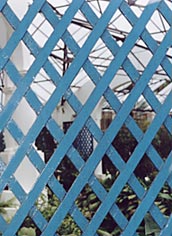 and after |
|
ON:
What is lacking to have almost ideal, viable conditions that publishing here, we can help in any way? ON: If you put a wonderful healthy plant, it will be easier to maintain. I am not talking about to cultivate there but to turn it into a display area, if it blooms, you put there. An area to attract people, I am thinking about this. People come here, turn around, drink water, look at those which are beautiful and go away. Which is the directive of the Botanical Garden concerning this non-expert public? Or there is no directive in this sense, because the function of the Botanical Garden and, particularly, the function of the Orchid Houses is some other? |
|
Marta:
What do you mean with non-expert public? Who is not botanist, who has no relation with the universe of the plants or who knows absolutely nothing plants? The most part of our visitors is inside this category. The arboretum of the Botanical Garden is, first of all , a place of recreation and public utility. The visitor with real interest in plants is rare. People come here to exercise, to breath, to think, to take a walk, to have a date and enjoy nature, not necessarily to see plants. I am talking about the arboretum as a whole and the Orchid Houses in particular. One of the functions of the BGRJ is exactly to make people change their way of looking, to educate and arouse the interest in the vegetal kingdom. Many people can't differentiate an orchid from a bromeliad or a fern. And with this level of ignorance, it is hard to appreciate. I think that is the reason for the success of those posters with information about orchids we have. I see people thrilling with the discovering they do when they read the texts. They are reading those posters, I think we are doing our part. |
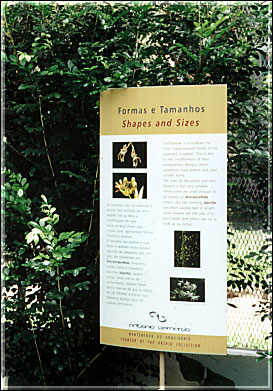 |
| ON:
What is the aim of the Botanical Garden's Orchid Houses? Marta: The tendency is not only to teach about orchids but also to teach about other plants because here is a place where you can compare. You have bromeliad, ferns, everything mixed. ON: However an orchid house is a orchid house. Bromeliad house is bromeliad house. There is no orchid in bromeliad house. Marta: In the glass greenhouse, I would like to make an evolution garden, showing the evolution of the vegetal kingdom, as there is in Kew Gardens which is something extraordinary, something to raise the hat to. When I went there, this garden was closed and I could not get in. I haven't gone there since long time ago, I did not see the new acclimated nurseries but they seem to be the best. I really regretted no to do this because I always have it in mind since I started studying plants. I should do something like this, showing the evolution of the plants, since the most primitive, closer to the dinosaur and go on showing what has been happing. ON: Why don't you do it here, outside, in this area which is not occupied? Marta: It would be very complicated, too much sun. Inside the glass greenhouse would be better. ON: You just can not produce more flowers because the luminosity is not enough. The climate here is very interesting although we are in Rio de Janeiro, the temperature drops down daily, which induces blooming, but with this problem of luminosity, it is very complicated. The photoperiod is good but with this roof of the lath house, blooming becomes hard. Marta: I know, the roof of lath house is bad. There are places left over to put plants however they are too shaded or the tiles are lacking and it rains. It is not very well adapted to orchids but we carry on. ON: So your mainly necessity at this moment, is really to get a sponsor to change the roof of the lath house? Marta: For sure. ON: Going back the problem of the greenhouse (octagon and corridor), we can see that, although you could not achieve all those projects, many species prosper very well here and bloom every year. How did you select the plants, you just put them there and move what does not fit? Marta: At the beginning, we avoid to let the plants inside the greenhouse after the bloom period. However, you could notice that those which stayed longer there, at random, in general, seem to be very happy. In reality, the high luminosity and the contrast between the heat and the dryness compensated by the daily watering, work well to the most species. ON: In spite of the difficulties you told us, we can see, nowadays, that the orchids are very well, not only in the greenhouse but also in everywhere here. Inside areas, corridor, internal garden. How did you do this distribution, this choice? Marta: How to organizer and display a collection of alive plants? That was my first interrogation when I arrived here and until now, I don't have the answer. The most simple is to dispose by genus and species, distributed in the most adequate environments (mainly concerning the luminosity). I thought, at the beginning, to do it by eco-systems. Esthetic and didactically is the most interesting. However constructing different environments is not easy, the landscape gardening is too expensive and we should collect representative species from different ecosystems that could thrive in cultivation and grow in association with orchids. Keeping different level of luminosity and humidity is not also an easy task, see the acclimated nursery of Kew Gardens. An ecosystem, for example, Atlantic Forest, covers since the coastal woods until the high fields, since zero to two thousands meter above sea level. How conciliate all those things? When the plants collected by Toscano arrived, I tried to keep them together, as well as the plants collected by other collectors. It is not the ideal but it is interesting to see together the orchids which are representatives from a certain area as we have here, for example, species from Pão de Açúcar, Floresta da Tijuca (Tijuca Forest), Macaé de Cima, Teresópolis, Pico do Cairuçu (Paraty), Aiuruoca (MG), Chapada Diamantina (BA). Briefly, we have been trying to have a little of everything. You know a live collection can not be static. |
| In the greenhouse, in the octagonal part, some exotic species grow very well, with good blooming, such: Arundina graminifolia, Renanthera sp, Vanda coerulea, |
|
Bulbophyllum
lobbii
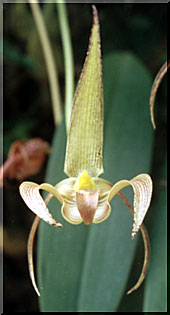 |
|
Arachnis
sp
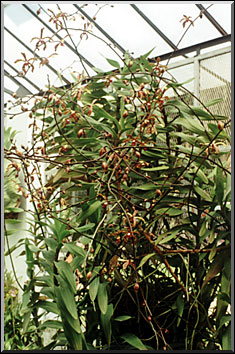 |
|
Spathoglottis
plicata
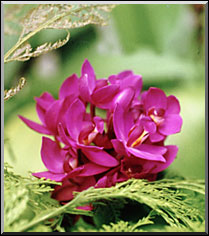 |
|
Papilionanthe
teres
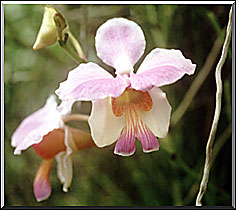 , , |
| We can find the Brazilian species: Oncidium baueri; Maxillaria brasiliensis; Cattleya labiata; Cattleya forbesii; Sobralia sessilis; |
|
Brassavola
tuberculata
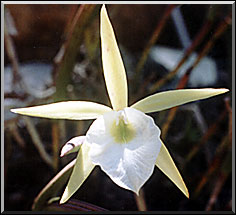 |
|
Maxillaria
rufescens
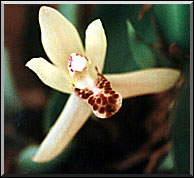 |
|
Maxillaria
ochroleuca
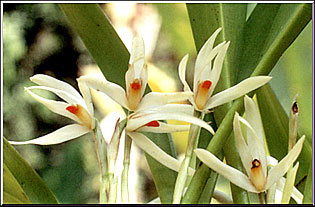 |
|
Pseudolaelia
vellozicola
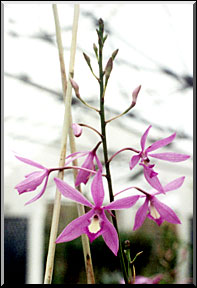 |
| Still in the greenhouse, in the corridor, more Brazilian species with a very good blooming: |
|
Cattleya
amesthysglossa
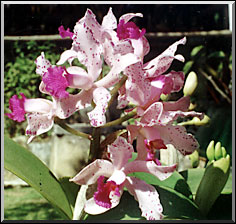 |
C.
tenuis
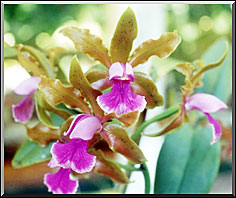 |
| C. granulosa, C. guttata, , C. loddigesii, Xylobium squalens, Miltonia spectabilis, Oncidium flexuosum, O. sarcodes, O. pumilum (Lophiaris pumila),Sobralia macrantha, Sobralia sp, |
|
Sobralia
liliastrum
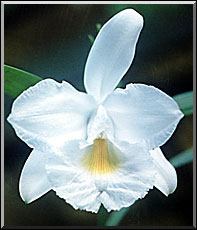 |
Laelia
grandis
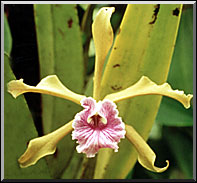
|
| many
species of Maxillaria (click
here to see some Maxillarias), many species of Epidendrum (click here to see some Epidendruns) and even Pleurothallis |
Pleurothallis
glumacea Lindl |
| There also are Renanthera, Vanda coerulea, Vanda tricolor. In the outside garden, we have Cattleya elongata, Cyrtopodium gigas and others, Laelia bahiensis, Encyclia alboxanthina, E. oncidioides, many Epidendrum, Catasetum, Cattleya forbesii. But the great part of the collection is in the lath house, the most part of the hybrids and Laelia andCattleya. ON: Which Cattleya species, bloom well here? Marta: Cattleya amethystoglossa, Cattleya elongata, Cattleya forbesii, Cattleya granulosa, Cattleya guttata, Cattleya harrisoniana, Cattleya intermedia, Cattleya leopoldii, Cattleya loddigesii, Cattleya maxima, Cattleya tenuis. ON: In spite of being at the sea level, with this very hot climate of Rio de Janeiro, although attenuate by the proximity of the wood and by the arboretum of the Botanical Garden itself, it seems that the species of Laelia bloom quite well here. At least, as already said, you have here a good drop of temperature at night. Marta: We have Laelia alaori, Laelia bahiensis, Laelia crispa, Laelia crispata, Laelia grandis, Laelia. kaustsky, Laelia lobata, Laelia perrini, Laelia purpurata, Laelia tenebrosa, Laelia virens, Laelia xanthina. Contrary to everyone recommends, Laelia lobata has just bloom after being repotted. A Laelia bahiensis grows in the inside garden, exposed to full sunbeam. ON: And Oncidium? Marta: Oncidium pulvinatum, Oncidium pumilum, Oncidium uniflorum, Oncidium sarcodes, Oncidium phymatochillum, Oncidium croesusand Oncidium varicosum are those which thrive better here. |
| It is expressly forbidden any kind of usage of any material of this site (text, photos, images, lay-out and any other), without the express authorization from the authors. |